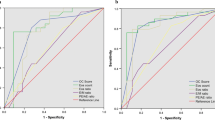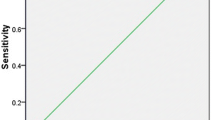Abstract
Purpose
To evaluate the putative association between subjective symptoms and eosinophilic inflammation in patients with chronic rhinosinusitis with nasal polyps (CRSwNP).
Methods
A total of 102 patients with CRSwNP who underwent endoscopic sinus surgery were prospectively enrolled. The Sinonasal Outcomes Test-22 scores (SNOT-22), EuroQol 5-dimensional Questionnaire scores (ED-5D), and Lund–Mackay scores by computed tomography (CT) were obtained. Patients were grouped as eosinophilic CRSwNP (eCRSwNP) and non-eosinophilic CRSwNP (neCRSwNP). ECRSwNP was defined if tissue eosinophils of nasal polyps were greater than or equal to 8/HPF according to positive major basic protein (MBP) staining, and neCRSwNP otherwise.
Results
Thirty neCRSwNP and 72 eCRSwNP patients were included. ECRSwNP patients had higher incidences of asthma (p = 0.001), allergic rhinitis (p = 0.001), and ethmoid-to-maxillary opacification ratio on CT scans (p < 0.001), whereas the proportion of purulent discharge (p < 0.001) and maxillary sinus score (p = 0.002) was higher in the neCRSwNP patients. There were no significant differences between patients on the mains of the EQ-5D health utility values and total SNOT-22 score. However, eCRSwNP patients had higher SNOT-22 scores of sneezing (p = 0.006), runny nose (p < 0.001), and ear/facial domain (p = 0.012), and lower scores of thick nasal discharge (p = 0.015) and blockage (p = 0.042). Sneezing, thick nasal discharge, and blockage/congestion of nose were recognized as independent factors of CRSwNP.
Conclusion
Sneezing was an independent predictor of eCRSwNP, and thick nasal discharge and blockage/congestion of nose were independent predictors of neCRSwNP.



Similar content being viewed by others
Data availability
The data that support the findings of this study are available from the corresponding author upon reasonable request.
References
Fokkens WJ et al (2020) European Position Paper on Rhinosinusitis and Nasal Polyps 2020. Rhinology 58(Suppl 29):1–464
Hopkins C (2019) Chronic rhinosinusitis with nasal polyps. N Engl J Med 381(1):55–63
Yu J et al (2021) Changes in clinical and histological characteristics of nasal polyps in northern China over the past 2–3 decades. Int Arch Allergy Immunol 182(7):615–624
Thompson CF et al (2016) A pilot study of symptom profiles from a polyp vs an eosinophilic-based classification of chronic rhinosinusitis. Int Forum Allergy Rhinol 6(5):500–507
Unsal AA et al (2021) Eosinophilic mucin: a predictor for disease severity in chronic rhinosinusitis. Am J Rhinol Allergy 35(2):187–194
Farrell NF et al (2021) Mucosal eosinophilia and neutrophilia are not associated with QOL or olfactory function in chronic rhinosinusitis. Am J Rhinol Allergy 35(5):647–655
Meng Y et al (2016) Predictive significance of computed tomography in eosinophilic chronic rhinosinusitis with nasal polyps. Int Forum Allergy Rhinol 6(8):812–819
Soler ZM et al (2009) Relationship between clinical measures and histopathologic findings in chronic rhinosinusitis. Otolaryngol Head Neck Surg 141(4):454–461
Stevens WW et al (2019) Associations between inflammatory endotypes and clinical presentations in chronic rhinosinusitis. J Allergy Clin Immunol Pract 7(8):2812-2820e3
Toro MDC et al (2021) Achieving the best method to classify Eosinophilic Chronic Rhinosinusitis: a systematic review. Rhinology 59(4):330–339
Wen W et al (2012) Increased neutrophilia in nasal polyps reduces the response to oral corticosteroid therapy. J Allergy Clin Immunol 129(6):1522–1528
Djupesland PG, et al (2022) Endoscopic grading systems for nasal polyps: are we comparing apples to oranges? Rhinology 60(3):169–176
Hopkins C et al (2009) Psychometric validity of the 22-item Sinonasal Outcome Test. Clin Otolaryngol 34(5):447–454
Katotomichelakis M et al (2013) Inflammatory patterns in upper airway disease in the same geographical area may change over time. Am J Rhinol Allergy 27(5):354–360
Kim SJ et al (2013) Changes in histological features of nasal polyps in a Korean population over a 17-year period. Otolaryngol Head Neck Surg 149(3):431–437
Jiang WX et al (2019) A retrospective study of changes of histopathology of nasal polyps in adult Chinese in central China. Rhinology 57(4):261–267
Wang W et al (2019) Changes in the clinical and histological characteristics of Chinese chronic rhinosinusitis with nasal polyps over 11 years. Int Forum Allergy Rhinol 9(2):149–157
Lou H et al (2016) Cellular phenotyping of chronic rhinosinusitis with nasal polyps. Rhinology 54(2):150–159
McHugh T et al (2020) Comorbidities associated with eosinophilic chronic rhinosinusitis: a systematic review and meta-analysis. Clin Otolaryngol 45(4):574–583
Pan X et al (2021) Evaluation of nasal symptoms to distinguish eosinophilic from noneosinophilic nasal polyps based on peripheral blood. Allergy Asthma Proc 42(3):214–221
Hu Y et al (2012) Diagnostic significance of blood eosinophil count in eosinophilic chronic rhinosinusitis with nasal polyps in Chinese adults. Laryngoscope 122(3):498–503
Yu L et al (2021) Predictive value of clinical characteristics in eosinophilic chronic rhinosinusitis with nasal polyps: A cross-sectional study in the Chinese population. Int Forum Allergy Rhinol 12(5):726–734
Quaranta N, Iannuzzi L, Gelardi M (2014) Does the type of rhinitis influence development of otitis media with effusion in children? Curr Allergy Asthma Rep 14(11):472
Seo Y et al (2015) Eosinophilic otitis media is associated with asthma severity and smoking history. ORL J Otorhinolaryngol Relat Spec 77(1):1–9
Soler ZM et al (2010) Impact of mucosal eosinophilia and nasal polyposis on quality-of-life outcomes after sinus surgery. Otolaryngol Head Neck Surg 142(1):64–71
Zhao K, Jiang J (2014) What is normal nasal airflow? A computational study of 22 healthy adults. Int Forum Allergy Rhinol 4(6):435–446
Liu C et al (2019) Predictive significance of charcot-leyden crystals for eosinophilic chronic rhinosinusitis with nasal polyps. Am J Rhinol Allergy 33(6):671–680
Tsuzuki K et al (2019) Predictors of disease progression after endoscopic sinus surgery in patients with chronic rhinosinusitis. J Laryngol Otol 133(8):678–684
Zhu MD, et al (2020) The roles of nasal nitric oxide in diagnosis and endotypes of chronic rhinosinusitis with nasal polyps. J Otolaryngol-Head & Neck Surg 49(1):68
Haxel BR, et al (2022) Real-world- effectiveness of biological treatment for severe chronic rhinosinusitis with nasal polyps. Rhinology 60(6):435–443
Xu XN et al (2022) Updates in biologic therapy for chronic rhinosinusitis with nasal polyps and NSAID-exacerbated respiratory disease. Allergy 77(12):3593–3605
Wu J et al (2018) Olfactory and middle meatal cytokine levels correlate with olfactory function in chronic rhinosinusitis. Laryngoscope 128(9):E304–E310
Han X et al (2020) Type 1/type 2 inflammatory cytokines correlate with olfactory function in patients with chronic rhinosinusitis. Am J Otolaryngol 41(5):102587
Funding
This work was funded by the Natural Science Foundation of Shanghai (No. 21ZR1411700) and the National Natural Science Foundation of China (No. 82000953).
Author information
Authors and Affiliations
Contributions
LH, XS, and DW contributed to the conception of the study. JC, QZ, and HX contributed to performing the data analyses. CZ and HW contributed to the manuscript preparation. HY and WL helped to perform the analysis with constructive discussions. All the authors contributed to the article and approved the submitted version.
Corresponding authors
Ethics declarations
Conflict of interest
The authors have declared that no competing interest exists.
Additional information
Publisher's Note
Springer Nature remains neutral with regard to jurisdictional claims in published maps and institutional affiliations.
Supplementary Information
Below is the link to the electronic supplementary material.
Rights and permissions
Springer Nature or its licensor (e.g. a society or other partner) holds exclusive rights to this article under a publishing agreement with the author(s) or other rightsholder(s); author self-archiving of the accepted manuscript version of this article is solely governed by the terms of such publishing agreement and applicable law.
About this article
Cite this article
Zhang, C., Wang, H., Zhang, Q. et al. Subjective symptoms as predictors for eosinophilic chronic rhinosinusitis with nasal polyps in the Chinese population. Eur Arch Otorhinolaryngol 280, 3721–3729 (2023). https://doi.org/10.1007/s00405-023-07905-1
Received:
Accepted:
Published:
Issue Date:
DOI: https://doi.org/10.1007/s00405-023-07905-1




